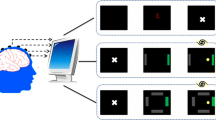Abstract
One crucial question in the design of electroencephalogram (EEG)-based brain–computer interface (BCI) experiments is the selection of EEG channels. While a setup with few channels is more convenient and requires less preparation time, a dense placement of electrodes provides more detailed information and henceforth could lead to a better classification performance. Here, we investigate this question for a specific setting: a BCI that uses the popular CSP algorithm in order to classify voluntary modulations of sensorimotor rhythms (SMR). In a first approach 13 different fixed channel configurations are compared to the full one consisting of 119 channels. The configuration with 48 channels results to be the best one, while configurations with less channels, from 32 to 8, performed not significantly worse than the best configuration in cases where only few training trials are available. In a second approach an optimal channel configuration is obtained by an iterative procedure in the spirit of stepwise variable selection with nonparametric multiple comparisons. As a surprising result, in the second approach a setting with 22 channels centered over the motor areas was selected. Thanks to the acquisition of a large data set recorded from 80 novice participants using 119 EEG channels, the results of this study can be expected to have a high degree of generalizability.




Similar content being viewed by others

References
Al-Ani A, Al-Sukker A (2006) Effect of feature and channel selection on EEG classification. In: Engineering in medicine and biology society, 2006. EMBS ’06. 28th annual international conference of the IEEE, pp 2171–2174. doi:10.1109/IEMBS.2006.259833
Blankertz B, Tomioka R, Lemm S, Kawanabe M, Müller K-R (2008) Optimizing spatial filters for robust EEG single-trial analysis. IEEE Signal Proc Mag 25(1):41–56
Blankertz B, Dornhege G, Krauledat M, Müller K-R, Curio G (2007) The non-invasive Berlin brain–computer interface: fast acquisition of effective performance in untrained subjects. NeuroImage 37(2):539–550
Dornhege G, del R Millán J, Hinterberger T, McFarland D, Müller KR (eds) (2007) Toward brain–computer interfacing. MIT Press, Cambridge, MA
Draper N, Smith H (1981) Applied regression analysis, 2nd edn. Wiley, New York
Engelbrecht AP (2005) Fundamentals of computational swarm intelligence. Wiley, Chichester, UK
Farquhar J, Hill NJ, Lal TN, Schölkopf B (2006) Regularised CSP for sensor selection in BCI. In: Proceedings of the 3rd international brain–computer interface workshop and training course, Graz, pp 14–15
Friedman JH (1989) Regularized discriminant analysis. J Am Stat Assoc 84(405):165–175
Gibbons JD (1985) Nonparametric statistical inference, 2nd edn. Marcel Dekker Inc., New York
Guyon I, Weston J, Barnhill S, Vapnik V (2002) Gene selection for cancer classification using support vector machines. Mach Learn 46(1–3):389–422
Hollander M, Wolfe DA (1973) Nonparametric statistical methods. Wiley, New York
Hocking RR (1976) The analysis and selection of variables in a linear regression. Biometrics 32:1–49
Hyvärinen A, Karhunen J, Oja E (2001) Independent component analysis. Wiley, New York
Jolliffe IT (2002) Principal component analysis, 2nd edn. Springer, New York
Lal TN, Schröder M, Hinterberger T, Weston J, Bodgan M, Birbaumer N, Schölkopf B (2004) Support vector channel selection in BCI. IEEE Trans Bio-Med Eng 51(6):1003–1010
Lv J, Meichun L (2008) Common spatial pattern and particle swarm optimization for channel selection in BCI. In: ICICIC ’08: Proceedings of the 2008 3rd international conference on innovative computing information and control. IEEE computer society, Washington, DC, pp 457–460. doi:10.1109/ICICIC.2008.196
McFarland DJ, McCane LM, David SV, Wolpaw JR (1997) Spatial filter selection for EEG-based communication. Electroencephalogr Clin Neurophysiol 103(3):386–394. doi:10.1016/S0013-4694(97)00022-2
Naeem M, Brunner C, Pfurtscheller G (2009) Dimensionality reduction and channel selection of motor imagery electroencephalographic data. Comput Intell Neurosci 2009, Article ID 537504, 8 pp. doi:10.1155/2009/537504
Popescu F, Fazli S, Badower Y, Blankertz B, Müller K-R (2007) Single trial classification of motor imagination using 6 dry EEG electrodes. PLoS ONE 2(7):e637. doi:10.1371/journal.pone.0000637
Ramoser H, Müller-Gerking J, Pfurtsheller G (2000) Optimal Spatial Filtering of single trial EEG during imagined hand movement. IEEE Trans Rehab Eng 4(8):441-446
Vidaurre C, Krämer N, Blankertz Benjamin, Schlögl A (2009) Time domain parameters as a feature for eeg-based brain computer interfaces. Neural Networks, Special Issue 22(9):1201–1358. doi:10.1016/j.neunet.2009.07.020
Vidaurre C, Schlögl A (2008) Comparison of adaptive features with linear discriminant classifier for brain computer interfaces. In: Engineering in medicine and biology society, 2008. EMBS 2008. 30th annual international conference of the IEEE, pp 173–176. doi:10.1109/IEMBS.2008.4649118
Wang Y, Gao X, Gao S (2005) Common spatial pattern method for channel selection in motor imagery based brain–computer interface. In: Proceedings of the 27th international IEEE EMBS conference, pp 5392–5395. doi:10.1109/IEMBS.2005.1615701
Acknowledgements
This work was supported in part by grants of the Deutsche Forschungsgemeinschaft (DFG), MU 987/3-1 - KU 1453-1, Bundesministerium für Bildung und Forschung (BMBF), FKZ 01IB001A/B - 01GQ0850 and by the FP7-ICT Programme of the European Community FP7-224631 - FP7-216886.
Author information
Authors and Affiliations
Corresponding author
Additional information
This is one of several papers published together in Brain Topography on the ‘‘Special Topic: Cortical Network Analysis with EEG/MEG’’.
Rights and permissions
About this article
Cite this article
Sannelli, C., Dickhaus, T., Halder, S. et al. On Optimal Channel Configurations for SMR-based Brain–Computer Interfaces. Brain Topogr 23, 186–193 (2010). https://doi.org/10.1007/s10548-010-0135-0
Received:
Accepted:
Published:
Issue Date:
DOI: https://doi.org/10.1007/s10548-010-0135-0



